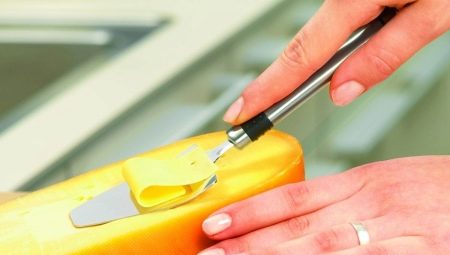Many people like cheese. But cutting it with ordinary knives is a very dubious pleasure. It is very important to choose a specialized cutting tool that will cope with this task as it should.
Features
Sandwich cheeses are easily cut with ordinary blades. But any professional culinary specialist and even just a gourmet cannot agree with such a decision. Cheese knives can be different. When creating a knife, the specific gravity and consistency of each product are taken into account. A cheese knife for cutting particularly soft varieties (dorblu and similar varieties) is not suitable, according to experts and experts, for cheese with a slightly larger strength. In its turn, both of these types of knives can not cope effectively enough with strong and extremely durable varieties of the product.
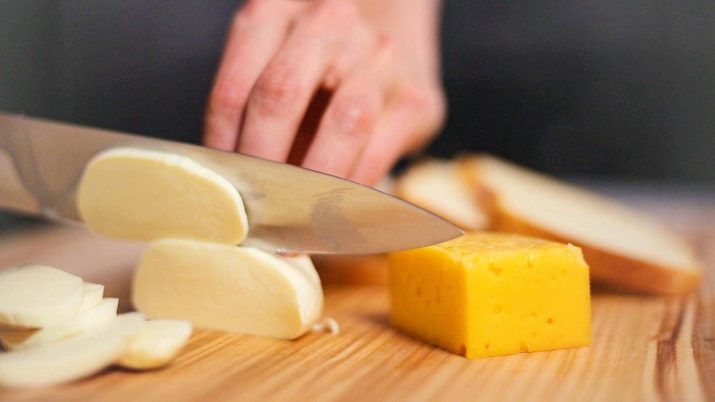
The taste of good cheese is not uniformly distributed over the weight of the workpiece. Even moving from the middle to the edges, gourmets recognize shades of taste. Therefore, lovers of this product believe that all the pieces should be cut with the expectation of smooth changes in taste. The vast majority of cheese knives are equipped with a handle located above the blade. This design greatly facilitates cutting and provides uniform pressure along the entire line. As a result, breaking and crumbling of the product is excluded.
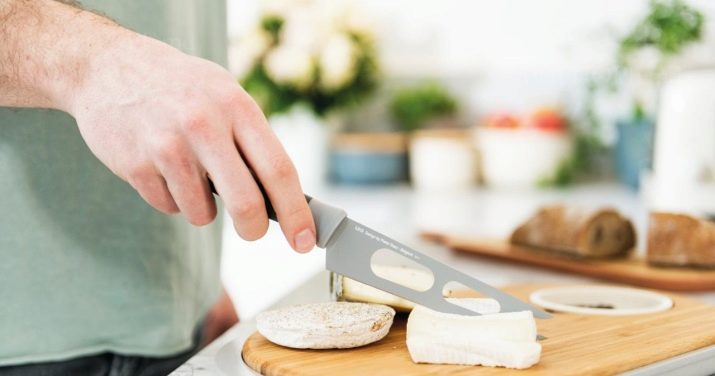
The length of the cheese knife should reach 0.37 m, the blade includes 0.24 m and the handle is 0.13 m. The blade should not be too thick - the maximum allowable metal layer is 1.6 mm. In this case, the maximum blade length can be only 0.4 m. A deviation of even 1 mm beyond the permissible dimensions is not allowed.
Sharpening a cheese knife should be done at an angle of strictly 20 degrees (for hard varieties) or 15 (if you need to process soft cheeses).
For cutting combined grades, along with straight knives, string devices, blades and a number of other designs can be used.
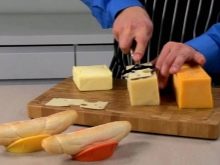
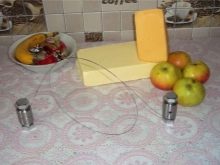
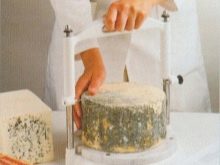
Important: if the knife is equipped with a ceramic blade, it is not suitable for slicing cheese. Pottery simply destroys the cheese and does not allow you to cut it correctly.
Normally, the tips are made of stainless steels with a high carbon content. A classic example is damask steel. You can use more modern alloys with a similar composition. The handle can be different, it is selected individually. A considerable part of experienced chefs believes that metal and fire-resistant plastic definitely lose to wood.

Varieties
But it is impossible to limit oneself to general requirements. Even if the knife for cutting cheese looks the same as a regular one, in fact it is arranged differently. The classic option is a long knife with an ergonomic handle structure. Company designers Samurawho developed this version, provided for the use of a wavy cutting edge. Special "air pockets" exclude sticking of cheese fragments to the surface of the knife. In the descriptions, it is noted that the joint of the blade with the handle is raised. This allows you to distribute the load as correctly as possible.

Professional chefs occasionally come across more unique tools, such as:
- parmesan knife;
- two-handed blade;
- grater knife;
- cheese planer.
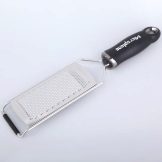
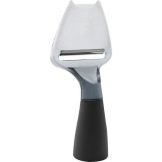
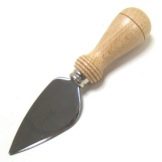

Professional fixtures usually have a narrow specialization. Sometimes they are designed to process one or more varieties of cheese. Because their purchase is not too much in demand. Classical modifications are good because they process hard and soft cheeses quite well. The vast majority of versions use bactericidal bolster, helping to effectively cut aged cheeses.
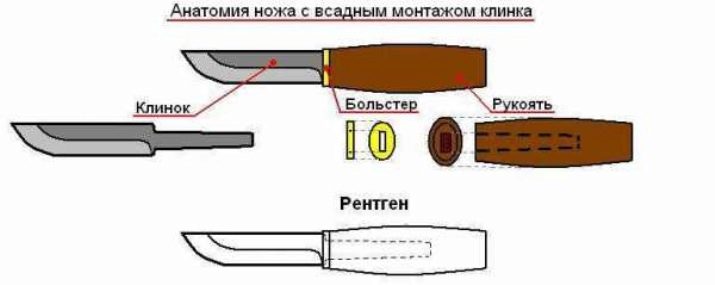
Products with two handles are usually used to cut very large heads. A conventional tool does not do this satisfactorily. And also a device called fat. It looks simple and unpretentious, but it effectively solves the task. Using fattyol is easy to chop:
- Swiss Tete de Muan;
- edam;
- smoked cheese brands;
- petit basque.
This tool is used in other cases. He is able to make “locks” of chocolate that look elegant on home baking. Rotating, the fat forms a chip that looks like lace. It is ideal for decorating various dishes. Externally fat is a round object with a central pin on which the cheese head is put on. Then twist the blade and handle. The rotation leads to the cutting of the upper layers with a sharp edge. These layers become a neat, lace-like chip.

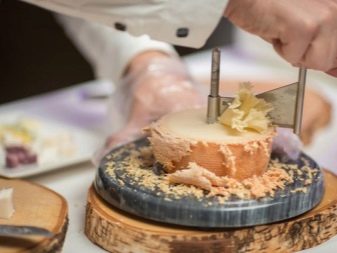
Shovel is a knife for soft cheese. Outwardly, it resembles an hatchet, and the instrument ends with a thin blade. The wooden handle is designed with a comfortable grip in mind, so cutting is easy and fast.
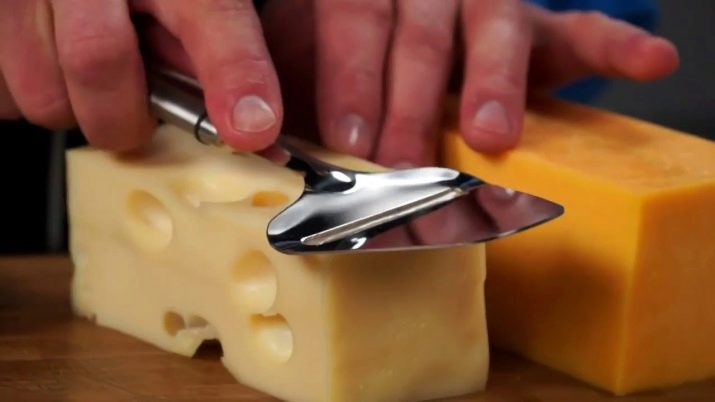
The traditional blade allows you to adjust the force of pressure. Therefore, it becomes possible to make pieces of precisely the specified thickness. Another type of scapula is knife with a side blade similar to a fork. A similar product is widely used for work with delicious cheeses. There are also shoulder blades with an elongated part: they are needed to spread ricotta or almette.
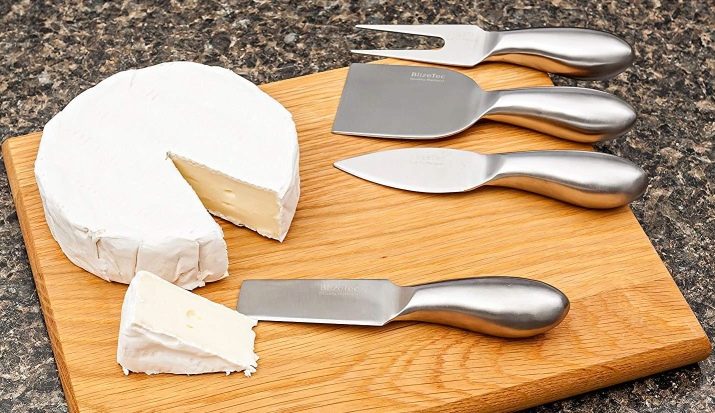
For the processing of soft cheese used string knife. Such a cheese cutter can turn even the least solid product into cubes with neat edges. This is an ideal solution for blue mold cheese, which under the edge of an ordinary knife turns into incomprehensible crumbs. But high quality strings can handle a moderately tough product.
String constructions are usually divided according to design into platform and intended for manual work. Stands come in different materials:
- wood (bamboo is often used);
- non-corrosive steel grades;
- glass.
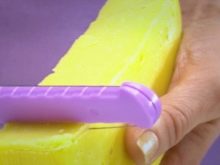


Manual and platform cheese knives can cut the head into segments of the required thickness. In most designs, this thickness is set rigidly during design. Only a few versions allow rotating special screws to adjust the size of the cut fragments. Processed cheeses are most often cut with knives with “windows” and with shaped teeth. These cloves allow you to grab and spread the sliced pieces on the dish.
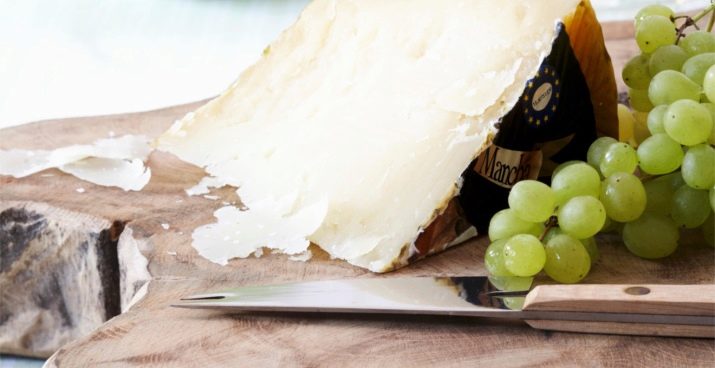
Parmesan is notable for its unusual properties: it is hard, but it is very brittle, it is easily divided into grains. Cut it completely unlike a regular knife tool. Rather, it looks like a plane and a chisel. The blade must have a large width, and it is necessary to apply special solutions that reduce the adhesion of chopped pieces. For this, either a Teflon coating is applied, or a special shape is made.
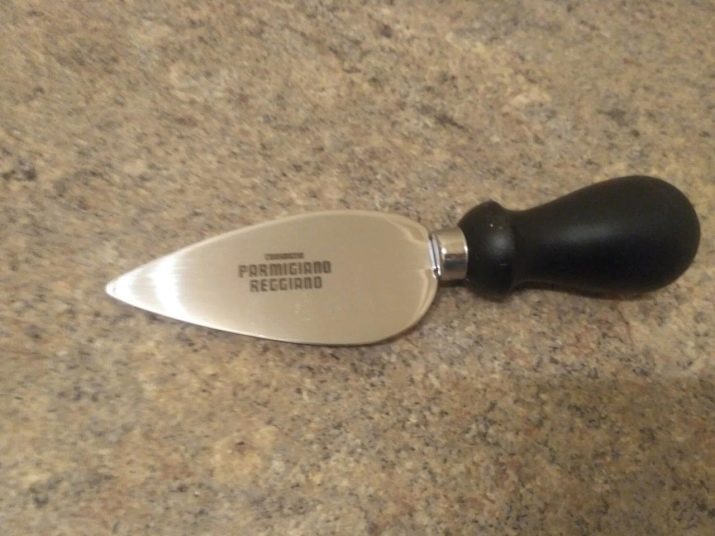
Smaller cheese heads are cut with about the same one-handed or two-handed knives, which are smaller in size. But there is an alternative solution - traditional swiss tool similar to a spatula. The blades of the “spatulas” can have a straight or semicircular shape.
Returning to Parmesan and other hard cheeses, we must immediately indicate that the top of the handle should be equipped with a metal insert. It is convenient to strike this top with a special hammer to remove a strong crust.
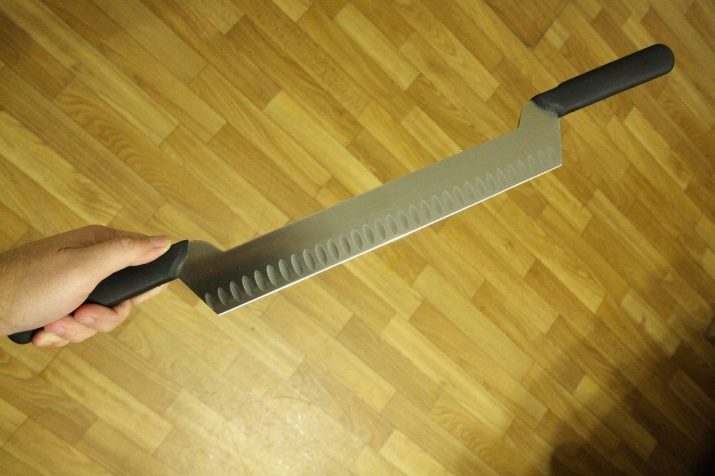
As for corrugated knives, they can help when working not only with cheeses, but also with vegetables, and even when slicing chips. In a separate group there are tools that allow you to cut:
- soft cheeses with mold crusts (Camembert);
- soft cheeses with washed crust (Limburg);
- blue cheese (Gorgonzola or Roquefort).
All such knives differ in frame design. A significant part of the metal is deliberately removed from the blade. Save only the frame with the cutting edge, butts and a certain number of ribs. The construction is completed by a double-toothed end fork, suitable for pricking and serving portioned cheese slices. Important: for products with each type of mold, use knives with a handle of the corresponding color.
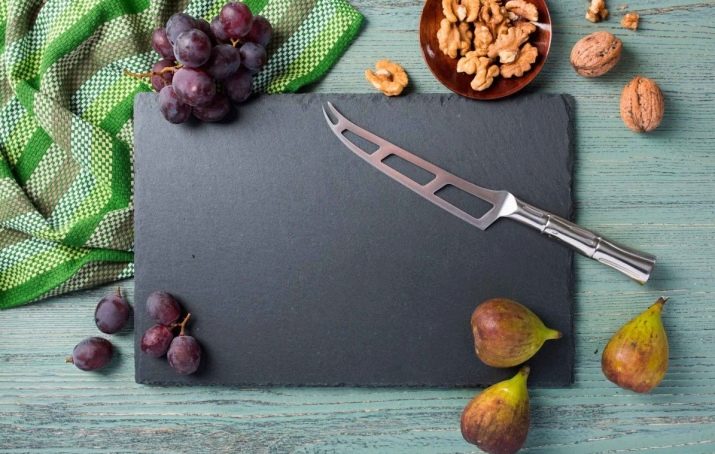
Popular brands
Gourmet-like cheeses are often used to work with soft cheeses. Wusthof knives manufactured by the German company Solingen. A feature of this version is the use of strong steel with the addition of vanadium and molybdenum. Plastic handles are very strong and last a very long time. The blade is equipped with holes to prevent sticking of sliced cheese, two-sided sharpening is performed according to a two-sided scheme.
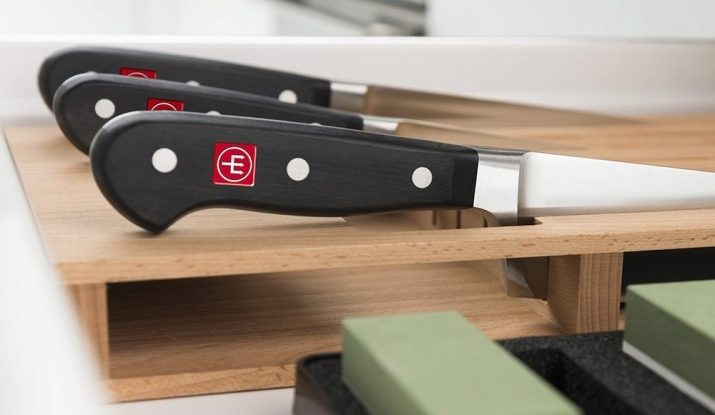
String Product Aluminum (manufactured by Westmark) Designed specifically for cutting a semi-solid product. Both the handle and the body are made of sturdy aluminum. The model will instantly prepare pieces of almost transparent thickness. Czech brand products are useful for working with parmesan Tescoma. Its characteristic feature is the large thickness of the handle, which is convenient to use.
Construction from Tupperware Provides covering edges with small cloves. This model is designed to work with Roquefort. A specific feature is 3 large holes. For the manufacture of pens used sturdy plastic. The package includes a convenient storage case.

Selection recommendations
For cutting cheese, only a knife with a blade is used, which contains 15% chromium and 10% nickel. The necessary information can be obtained from the marking. Models for soft cheese, which is hard to cut, always have recesses in the middle. But for a solid product, other modifications are needed that look similar to a spatula or chisel. With such a tool, cutting into portioned pieces and removing strong crusts is not difficult.
For the type of kitchen, the type of steel is of no small importance. Damascus alloy is very expensive and not everyone can afford it.However, it will allow you to stand out from other consumers, and if you have money, you should choose it. As already mentioned, many culinary specialists hold special views on what kind of material will be the best for the handle. Here you need to be guided only by personal tastes, and not by someone else's advice.
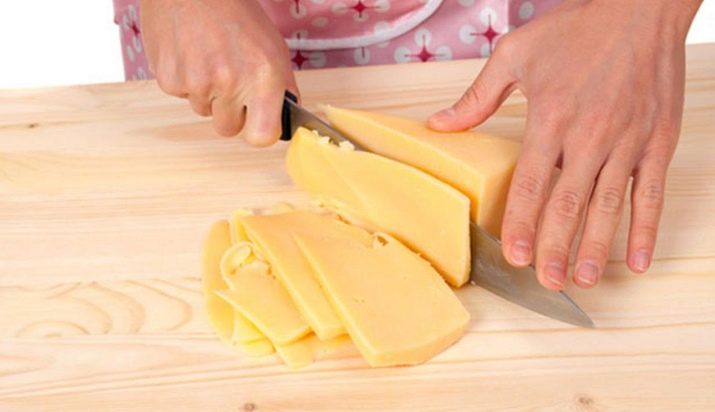
The same goes for knife design. So, Samura models embody the traditional elegance of a Japanese approach. However, they are rejected by some people. The set must include a knife for parmesan. Note: if the manufacturer supplies his knives in a wooden case, then this is very convenient and indicates the quality of the products.
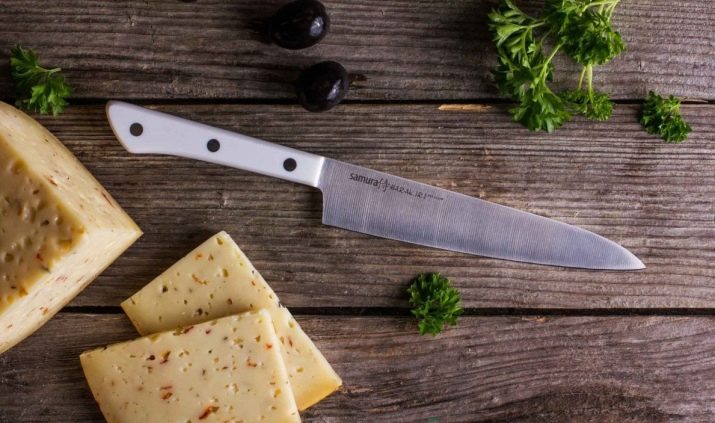
If you need to choose not a whole set, but only a separate copy, you need to give preference to knives for cheeses of medium softness. They are more or less suitable for a very soft and extremely hard product. Those who can not consider themselves a gourmet can be limited to one device with serreytornoy sharpening. When buying a kit, you should not give preference to the largest number of knives. Most manufacturers include in sets of 1 or 2 tools that are almost useless in everyday life.
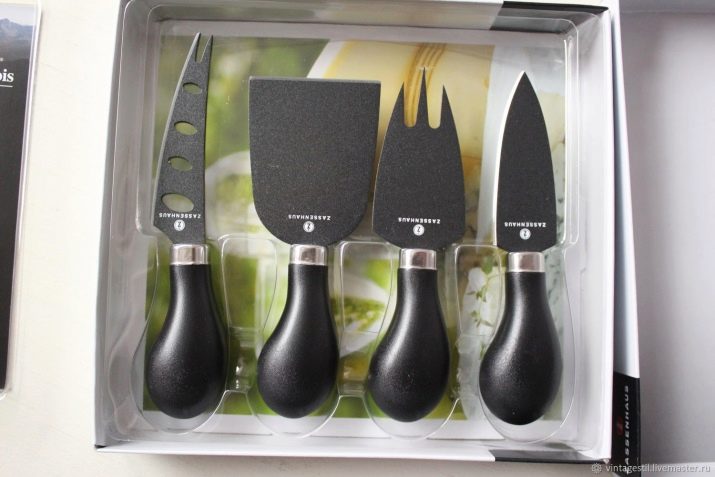
Subtleties of use
Whatever knife or the whole set was purchased, it is very important to use it correctly. If you make a mistake in this case, if you cut the cheese incorrectly, no constructive perfection will help. When a cheese planer is in your hands, you need to move it on yourself. This results in thin sheet shavings. Parmesan, characterized by extreme hardness, is not cut in the usual sense of the word, but split into pieces.
In any piece, there must be a crust, a middle, and the main part of the head. Use for each kind of cheese you need your own special knife.
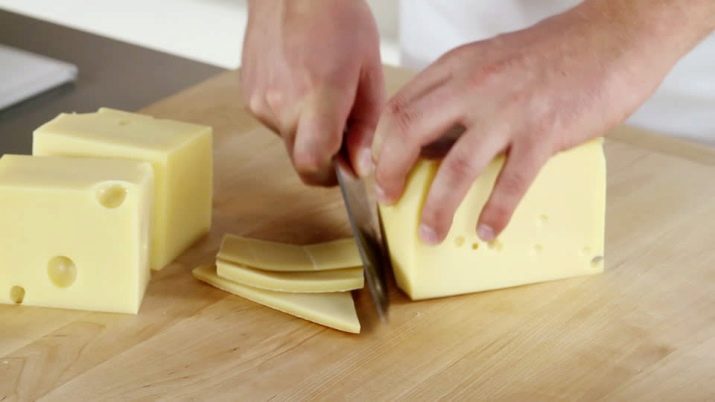
The point is not only the convenience of cutting, but also to exclude the mixing of tastes and smells. The knife must be held parallel to your body - this is the only right position. The end part of the blade is always directed away from itself and strictly down, this is the safest and most practical orientation.
Do not push the knife too hard. If after passing through the head he will hit the cutting board or other surface, then this will be:
- impractical (without any benefit);
- too noisy;
- unsafe
- harmful to the blade (shortens its service life).
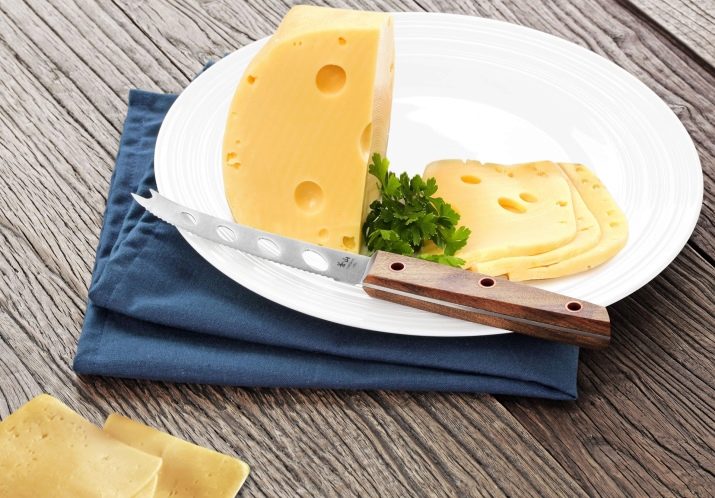
Storage and care
But even if the kitchen tool is used correctly, errors in its storage and improper care can be very harmful.
Any chef knows that in order for a cheese knife (and any other) to work as long as possible, it must be located where it is convenient to reach it with your hands.
A modest sized kitchen uses hinged magnetic holders. If there is enough space, use a conventional stand. Important: rotating stands are more comfortable than usual - they allow you to quickly get to the right tool.
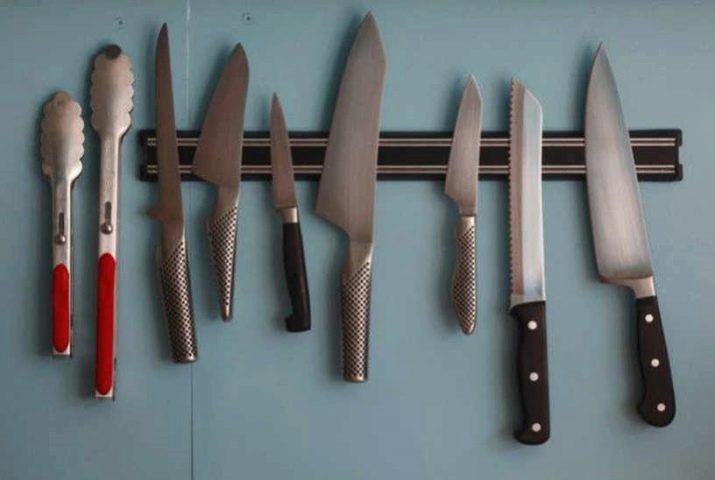
Categorically it is impossible to stack knives in bulk in boxes, in boxes and on shelves. This leads to rapid loss of sharpness and rust. It is extremely important: each tool should be used only for the work for which it is intended. The best boards are wooden; when they come in contact with them, the blades are least blunt. When the work is finished, the knives are washed immediately, and then the blades are wiped.
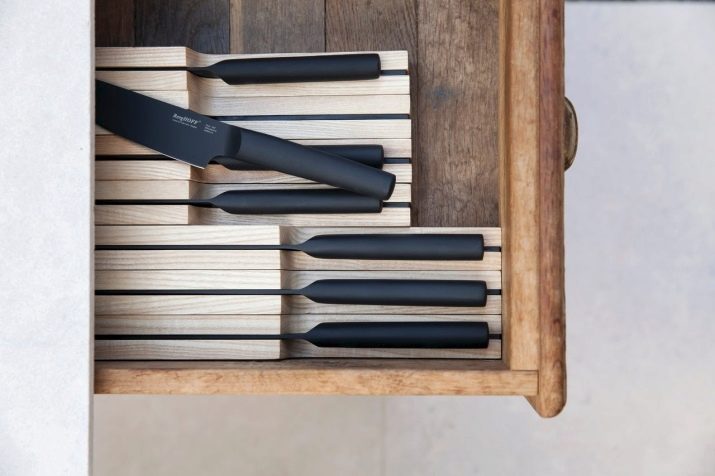
In the next video, you will learn how to use different types of knives for different cheeses.
